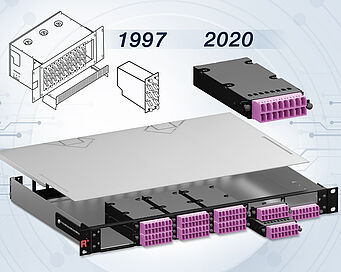Digitalization poses great challenges for organizations and companies. One of them is the exponentially growing amount of enterprise data that has to be transmitted and stored every day, more and more often in real time. In addition, mission-critical applications require maximum reliability and even low downtime is unacceptable. And there is no end in sight to this development: Modern technologies will continue to require more bandwidth in the future and further increase the need for cabling with high packing density and low attenuation loss. The choice of a future-oriented cabling infrastructure is crucial in order to meet this demand and successfully prepare for the approaching flood of data. Modern data centers today already rely on modular systems with a high packing density, which enable future network extensions as well as fast and simple system configuration and maintenance.
Parallel Optics: New solutions for increasing data rates
Parallel Optics applications increase data throughput and make information available in real time. And this is exactly where MTP® cabling systems come into play. An MTP®/MPO connector generally contains 4+4 OCTO, 12, 16, 24 or 32 fibers and can be used for parallel optical applications such as Infiniband with data rates up to 120 Gb/s, as well as for Ethernet protocols with 40/100/200/400 Gb/s over OM3 and OM4 multimode fibers. The rapid development of parallel optical data transmission has resulted in numerous GBE protocols for various applications: 40 GBE, 100 GBE, 200 GBE, 400 GBE, combined with abbreviations such as SR4, PSM4, DR2, DR4, CLR4, LR4, ER4, FR4, FR8, LR8, SR10, SR16.
Until recently, parallel optical data transmission with the Ethernet applications 40GbE-SR4, 100GbE-SR10, 100GbE-SR4 or the Fibre Channel application 4x16GFC was a domain of multimode cabling. However, the length limitations (maximum 150 m) for these protocols on multimode fibers quickly led to limitations in the cabling structure. The Ethernet transmission protocol 100 GBE-PSM4 removes the narrow length limitation of the multimode variant.
The PSM4 technology was developed as a cost-effective singlemode variant that can serve transmission distances of 500 meters with a channel attenuation of 3.26 dB. As part of this development, Rosenberger OSI has extended its PreCONNECT® OCTO cabling concept to singlemode applications. Based on the SR4 and PSM4 protocols, eight fibers are connected with PreCONNECT® OCTO, even if the MTP® 12-way connector serves as the interface. By optimally utilizing all fibers, the eight-fiber design of the MTP® connectors significantly reduces installation costs. The elimination of unnecessary interfaces and module cassettes saves additional budget and reduces channel attenuation. The migration of duplex infrastructure cabling to SR4 applications is also even easier, as existing infrastructure cabling can be migrated without great effort using migration harnesses.





